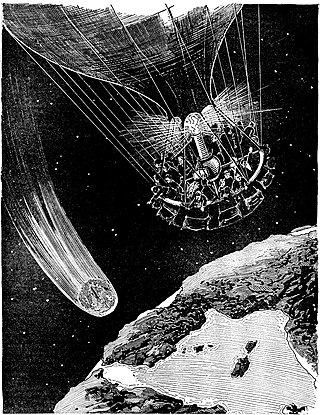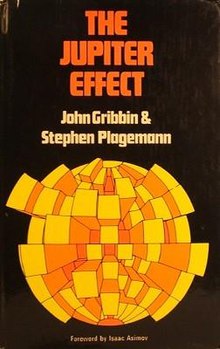
A planet is a large, rounded astronomical body that is neither a star nor its remnant. The best available theory of planet formation is the nebular hypothesis, which posits that an interstellar cloud collapses out of a nebula to create a young protostar orbited by a protoplanetary disk. Planets grow in this disk by the gradual accumulation of material driven by gravity, a process called accretion. The Solar System has at least eight planets: the terrestrial planets Mercury, Venus, Earth, and Mars, and the giant planets Jupiter, Saturn, Uranus, and Neptune.

An impact event is a collision between astronomical objects causing measurable effects. Impact events have been found to regularly occur in planetary systems, though the most frequent involve asteroids, comets or meteoroids and have minimal effect. When large objects impact terrestrial planets such as the Earth, there can be significant physical and biospheric consequences, as the impacting body is usually traveling at several kilometres a second, though atmospheres mitigate many surface impacts through atmospheric entry. Impact craters and structures are dominant landforms on many of the Solar System's solid objects and present the strongest empirical evidence for their frequency and scale.

In astronomy, a transit is the passage of a celestial body directly between a larger body and the observer. As viewed from a particular vantage point, the transiting body appears to move across the face of the larger body, covering a small portion of it.

The Late Great Planet Earth is a 1970 book by Hal Lindsey, with contributions by Carole C. Carlson, first published by Zondervan. The New York Times declared it to be the bestselling "nonfiction" book of the 1970s. The book was first featured on a primetime television special featuring Hal Lindsey in 1974 and 1975 with an audience of 17 million and produced by Alan Hauge of GMT Productions. It was adapted by Rolf Forsberg and Robert Amram into a 1978 film narrated by Orson Welles and released by Pacific International Enterprises.

A classical planet is an astronomical object that is visible to the naked eye and moves across the sky and its backdrop of fixed stars. Visible to humans on Earth there are seven classical planets. They are from brightest to dimmest: the Sun, the Moon, Venus, Jupiter, Mars, Mercury and Saturn.

In astronomy, an extraterrestrial sky is a view of outer space from the surface of an astronomical body other than Earth.

The Hill sphere is a common model for the calculation of a gravitational sphere of influence. It is the most commonly used model to calculate the spatial extent of gravitational influence of an astronomical body (m) in which it dominates over the gravitational influence of other bodies, particularly a primary (M). It is sometimes confused with other models of gravitational influence, such as the Laplace sphere or being called the Roche sphere, the latter causing confusion with the Roche limit. It was defined by the American astronomer George William Hill, based on the work of the French astronomer Édouard Roche.

The Nibiru cataclysm is a supposed disastrous encounter between Earth and a large planetary object that certain groups believed would take place in the early 21st century. Believers in this doomsday event usually refer to this object as Nibiru or Planet X. The idea was first put forward in 1995 by Nancy Lieder, founder of the website ZetaTalk. Lieder claims she is a contactee with the ability to receive messages from extraterrestrials from the Zeta Reticuli star system through an implant in her brain. She states that she was chosen to warn mankind that the object would sweep through the inner Solar System in May 2003 causing Earth to undergo a physical pole shift that would destroy most of humanity.

John R. Gribbin is a British science writer, an astrophysicist, and a visiting fellow in astronomy at the University of Sussex. His writings include quantum physics, human evolution, climate change, global warming, the origins of the universe, and biographies of famous scientists. He also writes science fiction.

Worlds in Collision is a book by Immanuel Velikovsky published in 1950. The book postulates that around the 15th century BC, the planet Venus was ejected from Jupiter as a comet or comet-like object and passed near Earth. The object allegedly changed Earth's orbit and axis, causing innumerable catastrophes that are mentioned in early mythologies and religions from around the world. The book has been heavily criticized as a work of pseudoscience and catastrophism, and many of its claims are completely rejected by the established scientific community as they are not supported by any available evidence.
Pantropy is a hypothetical process of space habitation or space colonization in which, rather than terraforming other planets or building space habitats suitable for human habitation, humans are modified to be able to thrive in the existing environment. The term was coined by science fiction author James Blish, who wrote a series of short stories based on the idea.

The 2012 phenomenon was a range of eschatological beliefs that cataclysmic or transformative events would occur on or around 21 December 2012. This date was regarded as the end-date of a 5,126-year-long cycle in the Mesoamerican Long Count calendar, and festivities took place on 21 December 2012 to commemorate the event in the countries that were part of the Maya civilization, with main events at Chichén Itzá in Mexico and Tikal in Guatemala.

Comets have appeared in works of fiction since at least the 1830s. They primarily appear in science fiction as literal objects, but also make occasional symbolical appearances in other genres. In keeping with their traditional cultural associations as omens, they often threaten destruction to Earth. This commonly comes in the form of looming impact events, and occasionally through more novel means such as affecting Earth's atmosphere in different ways. In other stories, humans seek out and visit comets for purposes of research or resource extraction. Comets are inhabited by various forms of life ranging from microbes to vampires in different depictions, and are themselves living beings in some stories.
In astronomy, a phase curve describes the brightness of a reflecting body as a function of its phase angle. The brightness usually refers the object's absolute magnitude, which, in turn, is its apparent magnitude at a distance of one astronomical unit from the Earth and Sun.

In astronomy, a syzygy is a roughly straight-line configuration of three or more celestial bodies in a gravitational system.
This is complete list of works by American science fiction and fantasy author Fred Saberhagen.
This is an incomplete list of works by American space opera and science fiction author Frederik Pohl, including co-authored works.

Comets is an anthology of science fiction short stories edited by Isaac Asimov, Martin H. Greenberg and Charles G. Waugh as the fourth volume in their Isaac Asimov's Wonderful Worlds of Science Fiction series. It was first published in paperback by Signet/New American Library in February 1986.
Syzygy is a 1981 novel by Frederik Pohl. It was inspired by the non-fiction work, The Jupiter Effect by John Gribbin and Stephen Plagemann, in which an alignment of the planets of the Solar System in March 1982 was predicted as possibly causing disasters on Earth, including a large earthquake in California, by its effect on the solar wind. The prediction did not come to pass, the theory was debunked, and Gribbin himself announced that he regretted publishing it.














